The Secretariat of Economy (SE), defines Foreign Investment as a complementary source of resources to finance the economic growth of our country, to generate greater sources of employment and technology transfer. According to the World Investment Report 2022 published by the United Nations Conference on Trade and Development (UNCTAD), Mexico ranked in 2021 as the 10th largest recipient of foreign direct investment (FDI) in the world, the 5th among developing economies, and the 2nd largest recipient of FDI in Latin America, with an average FDI of 29 billion dollars per year.
According to figures from the SE, Mexico received 31,517 million dollars of FDI in 2021, which has been mostly designated to the manufacturing industry. One of the objectives of the Mexican Government is to position the country as one of the main destinations for foreign investment for the benefit of the manufacturing sector in all states and municipalities. Furthermore, in the last 10 years, the country has remained at suitable levels, totaling more than 300,00 million dollars between 2011 and 2021, which have been directed mainly to the manufacturing, financial, mining, commercial, construction, real estate, tourism, information media, professional services and transportation sectors.
The countries that have invested the most in Mexico are, in first place, its partners in the Mexico-United States-Canada Agreement (T-MEC), followed by a significant number of European countries (the Netherlands, Spain, Belgium, Germany, the United Kingdom, Luxembourg and Switzerland) and Asia (Japan).
But what are the advantages that Mexico has for foreign investors?
Undoubtedly, one of the main advantages is its strategic location, since Mexico is right in the middle of two large markets, the North American and Latin American, has access to the Pacific and Atlantic Oceans, and shares a time zone and a 3,152 km northern border with the largest economy in the world, the United States. This excellent geographic location allows business opportunities with the northern countries (United States and Canada) or to Latin America with advantages superior to other countries in the region, including transportation costs.
In addition to its wide openness and trade agreements, in 2021, Mexico’s trade openness was 82%, which is accompanied by the signing of 14 free trade agreements that allow preferential access to 50 countries that represent more than 1.3 billion consumers and 60% of the world’s gross domestic product. The treaties that have been signed strengthen the insertion of Mexican products in international markets, as well as favoring the conditions of foreign products on their way to their final market. This advantage has also made Mexico a key player and exporting power in the global arena; Mexico ranked 12th in world exports in 2021, participating with 2.3% of the total.
The treaties that it currently subscribes to are as follows:
|
7. Uruguay |
|
8. Japan |
|
9. Peru |
|
10. Central America (Costa Rica, El Salvador, Guatemala, Honduras and Nicaragua) |
|
11. Panama |
|
12. Pacific Alliance (Chile, Peru and Colombia) |
| 13. TIPAT (Australia, Brunei Darussalam, Canada, Chile, Japan, Malaysia, New Zealand, Peru, Singapore and Vietnam) | 14. United Kingdom |
It is currently in the process of signing the EU-Mexico FTA 2.0, the modernized treaty with the European Union, and in negotiations for an FTA with South Korea.
Mexico also has a flexible investment regime that allows foreign participation in almost all activities, with governmental and administrative support to carry out the project, and programs to promote industry and exports, as part of the policies to attract investment.
NOTE-Maquiladoras in Mexico may not have to pay duties or taxes on material imported temporarily for manufacturing.
Another of Mexico’s human capital advantages is its cheap, qualified, young and competitive labor force; approximately half of the population is economically active (in 2021, the EAP was 59.5 million people, which implied a participation rate of 59.6 percent). It is one of the 10 countries with the highest number of young engineering graduates worldwide. And even with all the benefits required by the LFT, the cost of the workforce is still very low compared to other countries.
The generation of an innovative environment is another one of the advantages that have been noted in recent years, with the creation of Mexican startups, where almost 3,000 million dollars have been raised, which represents a historical value in the last 9 years. A startup is an emerging company that has as a distinctive factor, the use of technology and innovation, whose main mission is to make a change in the daily activities of society through disruptive business models, products and services.
Its abundant natural resources and materials for production, make the country megadiverse with a great variety of microclimates and materials that favor different activities. At the same time, it is positioned as the second most visited destination for international tourism, with more than 30 million foreign tourists a year.
The federal government is developing strategic infrastructure projects in the region to ensure that goods move to their final destination, supporting the creation of seaports, airports, railways and highways to enable efficient connections.
- It has extensive air, land and maritime connectivity, with 49 customs offices (11 inland customs offices, 17 maritime customs offices and 19 customs offices on the northern border), 117 ports and terminals. After its expansion in 2014, the Port of Lázaro Cárdenas became the largest logistics hub in Latin America.
- The National Port System is comprised of 117 ports and terminals, of which Veracruz, Altamira, Manzanillo and Lázaro Cárdenas stand out above all for their location, facilities, storage capacity and diverse cargo that make them extremely strategic for the country’s economic development.
- The National Road Network (RNC) includes 171,346 kilometers of highways, 340,287 kilometers of rural roads and 70,540 kilometers of highways, totaling 582,174 kilometers for the movement of products and other services in Mexico.
- There are around 500 industrial parks in Mexico at maximum capacity, which means that there are companies attracted by nearshoring that have been waiting for the creation of new parks, which are a type of investment often announced in the same way. These parks are mainly concentrated in Nuevo Leon (95), Baja California (91), State of Mexico (64), Jalisco (58) and Guanajuato (55).
This document does not constitute a particular consultation, and therefore, Asesores Stratego SC, is not responsible for the interpretation or application given to it. The total or partial reproduction of this publication, by any means or procedure, is prohibited without the prior, express and written authorization of the author. Any form of unauthorized use will be prosecuted in accordance with the provisions of the Federal Copyright Law. We are at your service to answer your questions or comments, for more information on this subject and our services, please contact us at: info@asesores-stratego.com
or application given to it. The total or partial reproduction of this publication, by any means or procedure, is prohibited without the prior, express and written authorization of the author. Any form of unauthorized use will be prosecuted in accordance with the provisions of the Federal Copyright Law. We are at your service to answer your questions or comments, for more information on this subject and our services, please contact us at: info@asesores-stratego.com

